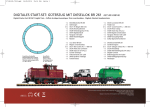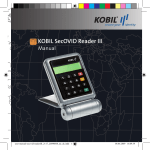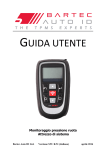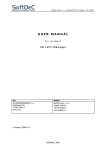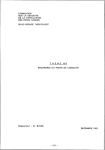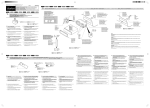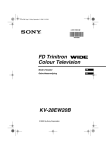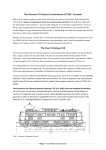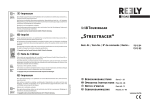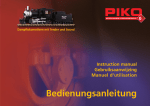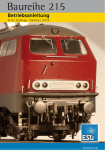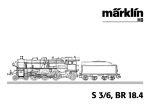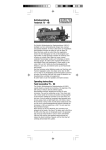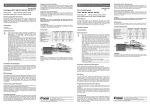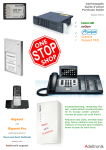Download Bedienungsanleitung - Champex
Transcript
Dampflokomotive BR 80 Instruction manual Gebruiksaanwijzing Manuel d’utilisation Bedienungsanleitung Lieber Großbahner, Wir freuen uns, dass Sie sich für dieses neue Modell aus dem Hause PIKO entschieden haben. Das Modell wurde während der Entwicklung intensiv von uns unter allen möglichen Realitätsbedingungen getestet, um Ihnen einen großen Fahrspaß und viel Freude damit zu gewährleisten. Dennoch möchten wir gerne Ihre Erfahrung im Praxisalltag kennen lernen, da der Praxis-Test im Allgemeinen immer noch härtere Anforderungen stellt, als sich dies unsere Entwickler vorstellen können. Bitte teilen Sie uns Ihre Eindrücke per E-Mail: [email protected], per Fax: +49 3675 897250 oder per Post an PIKO Spielwaren GmbH, PF, 96505 Sonneberg/Thüringen mit. Über Positives freuen wir uns natürlich am meisten, aber auch negative Erfahrungen oder Verbesserungsvorschläge helfen uns bei der Weiterentwicklung dieses und weiterer geplanter Modelle. Herzlichen Dank für Ihre Unterstützung. Ihr PIKO Team 2 Das Vorbild Die Lokomotiven der BR 80 waren im Typenprogramm der Deutschen Reichsbahn als Rangierlokomotiven auf großen Verschiebebahnhöfen vorgesehen. Wenig bekannt ist, dass die Entwicklung aller deutschen Einheitsdampfloks ihren Ausgangspunkt in der Planung einer Ersatzlok für die preußische T 3 hatte. Die BR 80 wurde zur Ursprungstype aller Einheitstenderlokomotiven. Doch betriebliche gute Wirksamkeit erreichten die Rangierloks nie, obwohl es durchaus bewährte Konstruktionsdetails gab. Verschiedene Lokomotivfabriken lieferten bis zum Jahre 1928 insgesamt 39 Maschinen der BR 80, die zunächst in Köln und Leipzig eingesetzt wurden. Die Mehrzahl der Lokomotiven verblieb nach dem letzten Krieg im Leipziger Raum und war dort bis 1968 im Einsatz. Zur DB kamen nur 17 Maschinen. Die letzten DB BR 80 wurden beim BW Schweinfurt 1965 ausgemustert. Einige Lokomotiven wurden von der DB an Großbetriebe und Zechen im Ruhrgebiet verkauft, wo sie bis Ende der siebziger Jahre ihren Dienst verrichteten. Von der BR 80 blieben sieben Exemplare, teils als Museumsloks erhalten. Das Modell Wie das Vorbild ist das Modell der BR 80 für Haupt- und Nebenbahnen als Rangier – oder Streckenlokomotive bestens geeignet. Das robuste Modell garantiert Spielspaß für drinnen und draußen, denn durch die Verwendung von speziellen Kunststoffen ist es wetterfest und somit auch im Freien einsetzbar Dennoch wird der Liebhaber keine Details vermissen. Technik • Ein kraftvoller Motor, spritzwassergeschützt • Zwei Achsen angetrieben • Stromabnahme von vier Rädern mittels Radschleifer • Zusätzlich zwei federnd gelagerte Schleifkontakte direkt auf der Schiene • Eingebautes Gewicht zur Erhöhung der Zugkraft • Beleuchtetes LED-Zweilichtsignal mit der Fahrtrichtung wechselnd weiß • Vorbereitet zum Nachrüsten eines Digital- und Soundsystems • Lautsprecheraufnahmefach • Bügelkupplung kompatibel mit dem LGB-System • Dampfentwickler nachrüstbar • Länge: 330 mm • Gewicht: ca. 1500 g Details • Detailliertes Gehäuse mit vielen vorbildgerechten Gravuren • Fein profilierte Speichenräder aus Zinkdruckguss • Separat eingesetzte Front- und Seitenscheiben • Separat angesetzte Lichtmaschine • Separat eingebaute Inneneinrichtung mit Lokführer • Freistehende Loklaternen auf der Pufferbohle • Nachbildung des Kohlevorrats im Tender • Teile aus speziellem Kunststoff für den Outdoor Gartenbetrieb • Vorbildgerechte Lackierung • Steuerung gealtert • Vorbildgerechte und komplette Beschriftung Erstbetrieb Ihrer Lok Technische Angaben Entnahme des Modells Entnehmen Sie das Modell bitte vorsichtig aus der Styroporverpackung, damit die Anbauteile wie Handstangen usw. nicht beschädigt werden. Nennspannung Das Modell wird innerhalb eines Spannungsbereiches von 0 bis 24 V betrieben. Stromversorgung Die Lokomotive benötigt Trafos oder Fahrregler, welche mindestens 1 A liefern. Verwenden Sie nur zugelassene und einwandfrei arbeitende Trafos oder Fahrregler. Antrieb Das Modell besitzt einen durchzugskräftigen Motor, welcher über ein robustes Getriebe zwei Achsen antreibt. Beleuchtung Das Modell ist mit einem beleuchteten LED-Zweilichtsignal mit der Fahrtrichtung wechselnd weiß ausgerüstet. Radius Das Modell durchfährt den kleinsten Radius von 600 mm. Erstbetrieb Wir empfehlen, die Lok jeweils ca. 30 min je Fahrtrichtung ohne Belastung einfahren zu lassen, damit das Modell einen optimalen Rundlauf und eine gute Zugkraft erhält. Bitte beachten Sie, dass der einwandfreie Lauf der Lok nur mit sauberen Schienen und Rädern gewährleistet ist. Zubehör Die Lokomotive ist werkseitig für den Einbau eines Dampfgenerators # 36140 analog bzw. # 36141 digital vorbereitet. Digital Decoder Das Modell ist werkseitig für den Einbau des PIKO Multiprotokoll Decoder # 36121 vorbereitet. Nach dem Einbau des Decoders kann die Lok auf digitalen Anlagen eingesetzt werden. Soundmodul Das Modell ist werkseitig für den Einbau eines originalen BR 80-Sounds, SoundModul # 36193, vorbereitet. Hierzu wird der Multiprotokoll Decoder # 36121 benötigt. Über einen Schnittstellenstecker kann es mit dem Multiprotokoll-Decoder verbunden werden. Das Soundmodul beinhaltet einen Breitbandlautsprecher mit einer wasserfesten Membrane. Wartung/Pflege Schmieren Bitte geben Sie nach ca. 25 Betriebsstunden nach lösen der Getriebeböden jeweils eine kleine erbsengroße Menge säurefreies und harzfreies Fett auf die Zahnräder. (siehe Schmierplan, Montageanleitung) Reinigen Reinigen Sie die Lok nach längerem Gartenaufenthalt mit einem milden Reinigungsmittel und einem fusselfreien Microfasertuch oder einem weichen Pinsel. Tauchen Sie auf keinen Fall die komplette Lok zum Reinigen in eine Lösung. Verschleißteile: Schienenschleifer und Radsatzkontakte sind Verschleißteile! Diese sollten nach ca. 500 Betriebsstunden getauscht werden! Achtung! Bitte beachten Sie, dass bedingt durch den Fahrbetrieb ein Abrieb an den mechanischen Teilen (Räder, Schleifer usw.) entstehen kann, welcher Verunreinigungen auf Teppichen oder anderen Materialien entstehen lässt. Austretendes Fett/Öl mit einem Tuch abwischen. Bei Schäden übernimmt die PIKO Spielwaren GmbH keinerlei Haftung. Achtung: Wichtige Sicherheitshinweise • Transformator regelmäßig auf Schäden an Kabeln, Steckern, Gehäuse und anderen Teilen überprüfen! • Bei einem Schaden darf der Transformator bis zur vollständigen Reparatur nicht mehr verwendet werden! • Lokomotive an nicht mehr als eine Energiequelle anschließen! • Kein Spielzeug. Nicht für Kinder unter 8 Jahren geeignet wegen funktions- und modellbedingter scharfer Kanten und Spitzen. • Lokomotive nur mit dem empfohlenen Transformator betreiben! • Der Transformator ist kein Spielzeug! • Vor der Reinigung, die Lok vom Transformator trennen! • Drähte nicht in die Steckdose einführen! 0-24 V 3 Dear G-Scale Train Enthusiast: Thank you for adding this PIKO model to your collection. It has undergone intensive testing throughout the development phase, as well as numerous inspections in the production process, to ensure you smooth operation and many years of trouble-free enjoyment. Of course, we welcome reports of your experience with the model under “real world” conditions, which even the most thorough developmental testing cannot completely duplicate. You can send us your comments by several methods: Via email to: [email protected] Via fax to: +49 3675 897250 Or via postal mail to: PIKO Spielwaren GmbH, PF 96505 Sonneberg/Thüringen Germany Naturally, we like to hear about positive experiences, but all comments help us improve this and future models. Thank you for your support, Your PIKO Team 4 The Prototype The BR 80s were used as shunting locomotives at large switchyards in the fleet of the Deutsche Reichsbahn. It is less well known that the development of all German standard steam locomotives arose from the planning of a replacement locomotive for the Prussian T3. The BR 80 became the original type for all standard tender locomotives. However, the shunting locomotive never reached good operational effectiveness, even though many of the engineering details were tried and tested. Up to and including 1928, several locomotive manufacturers made a total of 39 BR 80 engines, which were first used in Cologne and Leipzig. Most of the locomotives remained around Leipzig after the last war, and were used there until 1968. The Deutsche Bahn (DB) only got 17 engines. The last DB BR 80 was decommissioned at the Schweinfurt Depot in 1965. Some of the locomotives were sold by the DB to large companies and coal mines, where they remained in service until the end of the seventies. There are seven remaining BR 80’s, some of which are maintained as museum engines. The Model Like its role model, the BR 80 is well suited for duty as a shunting or mainline locomotive for main lines or branch lines. The robust model guarantees fun both indoors and out, because the use of special plastics make it weatherproof and suitable for use outside. At the same time, enthusiasts will not miss any details. Technical Features • A powerful precision “can“ motor • Gearing on two axles through a powerful motor • 4 wheels are equipped with wheel wipers for electrical pickup. • 2 additional sliding pickup shoes ride directly on the rails for reliable electrical pickup • Heavy weight concealed inside the body for added pulling power and reliability. • LED-lighted lanterns on each end change according to the direction of travel • Prepared for installation of PIKO digital decoder and sound unit (operates on digital only) • Includes speaker enclosure • Standard hook and loop couplers are compatible with most G-Scale trains. • Prepared for installation of a smoke generator • Length: 330 mm • weight: approx. 1500 g Details • Feature different and accurate individual details • Finely moulded spoked wheels made of zinc die-cast • Separately applied front windshield and side windows • Separately attached dynamo • Detailed cab interior with driver figure • Free-standing locomotive lantern on the buffer beam • Replica of the coal supply in the tender • UV- and weather-resistant materials for years of outdoor garden railway service • Authentic color schem • Aged side rods • Authentic and comprehensive lettering and decoration Getting Started: Initial Operation Technical Data Unpacking the Model Remove the styrofoam packaging extremely carefully to prevent damaging accessories and attached parts such as handrails etc. Power Supply The model should only be operated on a pure, filtered DC power supply of 0 to 24 volts, with a capacity of at least 1 Amp and a fast-acting fuse or circuit breaker to protect against short circuits. Do not use a power supply which is not in safe and perfect working condition. (See “Digital Decoder” section for operation on digital power.) Mechanism The locomotive has a powerful highprecision motor, which turns the wheels through a robust gearbox. Lighting The model is equipped with automatic directional headlights, using white LEDs for a realistic appearance. The “front” lights are illuminated according to the travel direction. Radius The locomotive can run on a track with a minimum recommended radius of 600 mm (23.62‘’). Add-On Smoke Generator The locomotive is prepared for installation of a Smoke Generator 36140 (17V for Analog DC) or 36141 (24V for Digital) Digital Decoder The model locomotive is prepared for “plug and play” installation of a PIKO # 36121 Multi-Protocol Decoder (available separately). As soon as the decoder is properly installed, the locomotive can be operated on digital as well as Analog DCpowered layouts. Initial Operation We recommend letting the locomotive run without a train for 30 minutes in both directions, to properly break it in. This will help achieve optimal performance and longevity for the locomotive. Of course, your model should only be run on smooth and perfectly clean tracks with reliable electrical contact to all track sections. Sound Module Only the model of the BR 80 is prepared for “plug and play” installation of a PIKO # 36193 Sound Unit (available separately). This reproduces authentic sounds of the real BR 80. It requires that the loco be equipped with a PIKO # 36121 multi-protocol decoder. The sound unit must be connected to the multiprotocol decoder via the included interface cable. The sound unit includes a high-quality extended frequency range speaker with a waterproof diaphragm for outdoor operation. Note: The sound unit is operable only on digital layouts, not on Analog DC-powered layouts. Maintenance Lubrication After each 25 hours of operation, and after any long periods of storage, please lubricate the locomotive's gears with a sparing amount of plastic-compatible, non-hardening grease. Remove the gearbox bottom cover and be careful to keep the front and rear wheelsets aligned with each other. Be sure to securely retighten the gearbox bottom cover screws. Cleaning If cleaning is necessary, use only a mild cleaning agent (such as soap and water) and gentle action with a soft non-abrasive cloth or brush. Never immerse the loco in liquid or “flood” any internal parts! Wheel Wipers and pick-Up shoes should be changed after 500 hours of operation. Please Note! Damage to Carpets and Other Surfaces: Normal operation of the locomotive causes wear of mechanical parts (wheels, electrical pickups etc.). This produces carbonized dust, grease and oil, which can permanently stain carpets, wood floors and other materials. It is the user’s responsibility to take proper precautions against this damage. Wipe any grease or oil from the track rails with a clean soft cloth. PIKO Spielwaren GmbH, as well as its representatives, distributors and retailers, assume no liability for any such damage. Please Note! Important Safety Precautions • Check the power supply regularly for any damage or problems. • Do not use a malfunctioning or damaged power supply! • This model must only be operated with one power source per circuit! • This product is not a toy, not suitable for personnel under 8 years of age. This product has small parts, sharp parts, and moving parts. • This model must only be operated with a safety-assured power supply! • The power supply is not a toy! • Disconnect the model from the power supply before cleaning or servicing! • Do not insert the track power connecting wires into household “mains” voltage outlets. 5 Cher Modéliste, Nous sommes heureux que vous ayez choisi une modèle à l’échelle G de fabrication PIKO. Elle a fait l’objet de toutes nos attentions durant sa conception et sa fabrication pour vous assurer beaucoup de joie et du plaisir à la conduire. Nous souhaitons cependant connaître votre expérience dans la pratique quotidienne avec notre le modèle car la pratique en général a plus d’exigence que ce que nos ingénieurs ont pu imaginer. Faites-nous part de vos impressions par email [email protected], par fax 0049 3675 89 72 50 ou par courrier postal à PIKO Spielwaren GmbH, PF, D96515 Sonneberg/Thüringen. Nous nous réjouirons bien évidemment de toute impression positive, mais un avis négatif ou une idée d’amélioration nous aideront et nous feront avancer pour les modèles futurs. Un grand merci pour votre soutien, L’Equipe PIKO 6 L’Original A la Deutsche Reichsbahn, les locomotives de la série 80 servaient de locomotives de manoeuvre dans les grandes gares de triage. C’est en étudiant le développement de toutes les locomotives unifiées allemandes à vapeur que l’on chercha une locomotive de remplacement pour la locomotive prussienne type T3. Les locomotives de la série 80 ont été à l’origine de toutes les locomotives tender unifiées. Pourtant les locomotives de manoeuvre n’arrivaient pas à avoir une bonne efficacité fonctionnelle, malgré certains détails de construction de haut niveau. Plusieurs usines livrèrent jusqu’en 1928 un total de 39 locomotives de la série 80 qui furent mises en service à Cologne et à Leipzig. A la fin de la dernière guerre, la plupart des locomotives se trouvaient dans la région de Leipzig et y étaient encore en service en 1968. 17 locomotives seulement furent affectées à la DB. Les dernières locomotives de la série 80 présentes à la DB furent réformées en 1965 à Schweinfurt. Quelques locomotives furent cédées par la DB à des entreprises de la région de la Ruhr, où elles restèrent en service jusqu’à la fin des années 1970. Sept exemplaires furent ensuite préservés par des musées. Le Modèle Réduit Comme la locomotive originale, le modèle réduit de la locomotive de la série 80 est tout à fait apte au travail de triage comme à la conduite sur des voies principales ou secondaires. Le modèle robuste est garant d‘un plaisir de jeu aussi bien à l’intérieur qu’à l’extérieur. En effet grâce à l’utilisation de matières plastiques spéciales, le modèle réduit est particulièrement résistant aux intempéries et peut donc être utilisé en plein air. Aucun détail ne manquera à l’amateur. Techniques • Un moteur puissant, protégé contre l’eau entraîne les deux essieux • Prise de courant sur les 4 roues au moyen de capteurs de roue • 4 frotteurs, en contact direct avec la voie • Lest supplémentaire intégré pour augmenter la force de traction • Signal 2 feux éclairés variant en fonction du sens de marche blanc • Prêt à recevoir un décodeur digital, un module sonore et un haut parleur • Attelage compatible avec le système LGB • Emplacement pour le haut parleur • Matériel prêt à recevoir un générateur de fumée • Longueur 330 mm • Poids environ 1.500 g Détails • Caisses séparées avec de nombreux détails de gravures • Roues à rayon finement dessinées • Fenêtres frontales et latérales rapportées • Eclairage indépendant • Poste de conduite aménagé avec conducteur • Phares indépendant sur la traverse de tamponnement • Reproduction de la réserve à charbon dans le tender • Pièces en plastique spécial pour fonctionnement en extérieur • Peinture conforme à la réalité • Embiellage vieilli • Tampographie complète et conforme à la réalité Mise en fonctionnement de votre locomotive Sortie du modèle Sortez le modèle délicatement de l’emballage en styropor afin que les pièces rapportées –mains montoires - ne soient pas endommagées 1er fonctionnement Nous vous recommandons de faire rouler la locomotive pendant 30 minutes dans chaque sens, sans charge, afin d’obtenir un fonctionnement optimal et une bonne puissance de traction. Veuillez noter qu’un fonctionnement sans faille du modèle n’est garanti que sur des rails propres. Caractéristiques techniques Tension nominale Le modèle fonctionne sous tension de 0-24 V CC. Consommation de courant Le modèle a besoin d’un transformateur ou variateur de vitesse qui délivre au minimum 1 A . N’utilisez que des transformateurs ou des variateurs autorisés et en bon état. Moteur Le modèle possède un moteur solide, qui fait fonctionner deux essieux grâce à une motorisation robuste. Eclairage Le modèle possède un éclairage avant blanc indépendant avec LED du sens de marche. Rayon Le modèle circule sur un rayon minimum de 600 mm Accessoires Le modèle est préparé d’usine pour l’installation d’un générateur de fumée, référence 36140 en système analogique, 36141 en système digital. Décodeur digital D’usine le modèle est équipé pour l’installation d’un décodeur PIKO multiprotocole réf 36121. Après l’installation du décodeur, la locomotive peut circuler sur des réseaux en système digital. Module sonore D’usine la locomotive BR 80 est équipée pour l’installation d’un module sonore reproduisant le son original des BR 80 réf PIKO 36193. Un décodeur multiprotocole 36121 sera nécessaire. Le module sonore peut s’enficher sur le décodeur multiprotocole ; il possède un haut parleur puissant avec une membrane étanche Entretien Graissage Il est recommandé de graisser les engrenages à travers toutes les 25 h de fonctionnement. (en manuel d’utilisation). Nettoyage Après un long séjour à l’extérieur, nettoyez votre locomotive avec un produit de nettoyage doux et un torchon micro fibre. Ne trempez en aucun cas la locomotive complète dans une quelconque solution pour la nettoyer. Attention: Veuillez noter que pendant le fonctionnement, un moteur peut toujours heurter les parties mécaniques (patins, roues) ou d’autres matériaux. Nettoyer avec un chiffon propre et doux tout surplus d'huile ou de graisse sur les rails. En cas de dommage, PIKO ne porterait aucune responsabilité. Attention: Conseils de sécurité importants • Inspectez régulièrement le transformateur afin de déceler d'éventuels dommages. • En cas d'endommagement, il ne faut absolument pas utiliser le transformateur avant une réparation totale des pièces! • Ce locomotive doit être raccordé à une seule source d'énergie! • Ne convient pas aux enfants de moins de 8 ans. Présence de petits éléments susceptibles d'être avalés. • Faire fonctionner ce jeu uniquement avec le transformateur que nous recommandons! • Le transformateur n'est pas un jouet! • Toujours débrancher la locomotive du transformateur pour procéder à un nettoyage! • Il est interdit d'introduire les fils de connexion dans une prise électrique! Changer les contact de rails et contacts d’essieux les 500 h de fonctionnement. 7 Beste liefhebbers van G-spoor, Het doet ons goed dat u heeft besloten tot de aanschaf van het nieuwe spoor-G-model van PIKO. Het model is tijdens de ontwikkeling onder alle mogelijke realistische omstandigheden intensief getest, zodat wij u veel rijplezier met de loc kunnen garanderen. Ondanks dat, willen wij graag uw praktijkervaringen met het G-spoor model leren kennen, omdat de echte praktijktest meestal nog zwaardere omstandigheden zal kennen, dan onze ontwikkelaars zich kunnen voorstellen. Wij verzoeken u om uw indrukken aan ons mede te delen per e-mail aan [email protected], per fax aan +49 3675 897250 of per post aan PIKO Spielwaren GmbH, Lutherstraße 30, 96515 Sonneberg/Thüringen. Op positieve berichten zijn wij uiteraard bijzonder gesteld, maar ook negatieve ervaringen en/of voorstellen tot verbetering helpen ons bij de verdere ontwikkeling van dit model en volgende modellen in G-spoor. Hartelijk dank voor uw ondersteuning! Uw PIKO Team 8 Het voorbeeld De locomotieven van de serie BR 80 waren bij de Deutsche Reichsbahn ingedeeld als rangeerlocomotieven op grote rangeerterreinen en bij stations. Niet zo bekend is, dat het uitgangspunt van de ontwikkeling van alle Duitse eenheidsstoomlocomotieven deze vervangingsloc voor de Pruisische T3 was. De BR 80 werd daarmee het basistype voor alle eenheidstenderlocomotieven. Helaas voldeden de locomotieven tijdens hun gebruik nooit volledig aan de verwachtingen, hoewel ze een aantal beproefde constructie-elementen bezaten. Verschillende locomotieffabrieken leverden tot 1928 in totaal 39 exemplaren af van de serie BR 80, welke werden ingezet in Köln en Leipzig. Het merendeel van de locomotieven verbleef na de Tweede Wereldoorlog in de omgeving van Leipzig en was daar tot 1968 in gebruik. Er kwamen slechts 17 machines naar de DB. De laatste DB BR 80 loc’s werden in 1965 bij BW Schweinfurt buiten dienst gesteld. Enkele locomotieven werden door de DB verkocht aan grote bedrijven en kolenmijnen in het Ruhr-gebied, waar ze tot het einde van de 70er jaren werden gebruikt. Van de BR 80 bleven zeven exemplaren behouden, deels als museumlocomotieven. Het model Net als het grote voorbeeld, is ook het model van de BR 80 het beste geschikt als rangeerloc of trekkracht op hoofden locaalspoorwegen. Het robuuste model garandeert speel-plezier voor binnen en buiten, want door het gebruik van speciale kunst-stoffen is de loc weerbestendig en daardoor ook in de buitenlucht te gebruiken. Ondanks dat, zal de lief-hebber geen detail missen aan het model. Techniek • Voorzien van een krachtige motor, weggewerkt in de spatwaterdichte behuizing van de aandrijving • Robuste aandrijving die twee assen aandrijft • Stroomafname via vier wielen middels contacten op de wielen • Bovendien twee afgeveerde sleepcontacten, direct op de rails • Een extra ingebouwde gewicht ter verhoging van de trekkracht • Een met de rijrichting wisselend tweelicht-sein aan beide fronten wit • Voorbereid voor het inbouwen van een digitaal- en soundsysteem • Voorbereid voor het inbouwen van een luidspreker • Beugelkoppeling compatibel met het LGB-systeem • Voorbereid voor de inbouw van een rookgenerator • Lengte: 330 mm • Gewicht: ca. 1500 g Detaillering • Verschillende behuizingen met werkelijkheidsgetrouwe detaillering • Fijn uitgevoerde spaakwielen van gegoten metaal • Separaat ingezet glas in de front en zijramen • Los aangezette dynamo • Ingerichte machinistencabine, compleet met machinist • Vrijstaande loclantaarns op de bufferbalk • Nabootsing van de kolenvoorraad in de tenderbak • Alle delen zijn vervaardigd uit speciaal kunststof dat geschikt is voor het ‘outdoor’ tuinbedrijf • Werkelijkheidsgetrouwe kleurstelling • Drijfwerk verouderd (geweatherd) • Werkelijkheidsgetrouwe en complete weergave van alle opschriften In gebruikname van uw loc Uitpakken van het model Neemt u het model na het openen svp voorzichtig uit de styroporverpakking, zodat alle losse delen, zoals handgrepen etc. niet worden beschadigd. In gebruikname Wij adviseren om de loc onbelast ca. 30 minuten naar iedere rijrichting te laten rijden, zodat het model optimaal wordt ingereden en een goede trekkracht ontwikkelt. Wij wijzen u erop, dat goede rij-eigenschappen van de loc uitsluitend gegarandeerd zijn op schone rails. Technische verklaringen Nominale spanning De bedrijfsspanning van het model is 0 tot 24 Volt DC. Stroomverzorging: Het model heeft een trafo of rijregelaar nodig, die minimaal 1 A levert. Gebruikt u svp uitsluitend trafo’s of rijregelaars die aan deze eis voldoen en die geen mankementen vertonen. Aandrijving: Het model bezit een krachtige motor, welke via een robuste aandrijving twee assen aandrijft. Verlichting: Het model is voorzien van een rijrichtingsafhankelijke tweepunts witte frontverlichting, dwz dat in de rijrichting vooruit de frontverlichting brandt. Radius: De kleinste radius die het model kan berijden bedraagt 600 mm. Accessoires Het model is van fabriekswege voorbereid voor de inbouw van een rookgenerator # 36140 analoog of # 36141 digitaal voorbereid. Digitale decoder: Het model is fabrieksmatig voorbereid voor de inbouw van de PIKO Multiprotocol decoder # 36121. Na de inbouw van deze decoder kan de loc worden ingezet op digitaal bestuurde modelbanen. Soundmodule: Het model BR 80 is fabrieksmatig voorbereid voor de inbouw van de originele BR 80-sound middels de PIKO soundmodule # 36193. Bij deze soundmodule heeft u tevens de multiprotocol decoder # 36121 nodig. Via een stekker kan de soundmodule met de multiprotocol decoder worden verbonden. De soundmodule wordt geleverd met een breedbandluidspreker met een waterbestendige membraam. Onderhoud Smeren: Na elke 25 bedrijfsuren zéér kleine hoeveelheden zuurvrij en harsvrij vet op de tandwielen doen. (zie het smeerschema, montagehandfleiding S. 2) Reinigen: De loc dient na langdurig tuinbedrijf uitsluitend gereinigd te worden met een mild reinigings-middel en een vezelvrije doek en/of een zachte kwast. Doop de complete loc in géén geval in een oplossing. Attentie: Let u er svp op, dat er door het rijden slijtage aan de mechanische delen (wielen, contactslepers, etc.) kan ontstaan, welke ertoe kan leiden dat er verontreiniging wordt veroorzaakt aan tapijt en andere materialen. Gelekt vet of olie met een zachte doek afvegen. Bij hierdoor veroorzaakte schade is PIKO Spielwaren GmbH op geen enkele wijze verantwoordelijk. Let op: Belangrijke veiligheidsvoorschriften • De transformator dient regelmatig op beschadigingen of defecten gecontroleerd te worden! • In geval van een beschadiging of defect mag de transformator niet langer gebruikt worden, totdat deze gerepareerd is! • De transformator mag uitsluitend middels één energiebron gebruikt worden! • Niet geschikt voor kinderen onder de 8 jaar omdat dit model funktionele scherpe kanten en punten bezit. • Het locomotief uitsluitend gebruiken met de aanbevolen transformator! • De transformator is géén speelgoed! • Vóór het reinigen, de transformator loskoppelen van de netspanning en het locomotief! • De verbindingsdraden mogen niet in het stopcontact worden gestoken! Wissel na elke 500 bedrijfsuren de railsleepcontact en de wielcontacten. 9 MONTAGEANLEITUNG BR 80 C C Service instructions · Manuel d’utilisation · Gebruiksaanwijzing C C C C 36193 Sound Kit nicht enthalten/ not included LED 36121 Decoder Kit nicht enthalten/ not included A A A LED A A C C C C C C 10 C C C C A wahlweise optional Bolzen / Crankpin Screws Boulon de manivelle / Bouten M 1:1 X Y X Z X = 6 x 24 Y = 6 x 17 Z = 6 x 14 Y Z C A B Y X A Z Schrauben / Screws Vis / Schroeven B Aufnahmefach für Reedkontakt Reed Switch Cover Caisse platine Contact reed Reedcontactprint M 1:1 A B B B A = 2,2 x 7 B = 2,2 x 10 C D C = 3,0 x 10 D = 3,0 x 14 11 Fetten Grease Graisse Smeren C C C C C C C C C C C C 36140/36141 Dampfgenerator Smoke Generator nicht enthalten/ not included A A LED LED D D D 12 D VERDRAHTUNGSSCHEMA DECODER – ANSCHLUSS-SCHEMA Wiring scheme · Schéma de câblage · Bedradingsschema Decoder wiring scheme · Schéma de câblage · Bedradingsschema M1 8 9 gelb/rot yellow/red jaune/rouge geel/rood 10 S1 rot red S2 schwarz black schwarz black S1 36121 Decoder Kit nicht enthalten/ not included LED vorn (-) gelb yellow schwarz black LED hinten (-) gelb yellow schwarz black M2 weiß white M1 gelb yellow Kühlkörper M2 7 rear side schwarz/rot black/red noir/rouge zwart/rood S2 6 loco 5 front side 4 hinten 3 Lok 2 LED vorn (+) LED hinten (+) schwarz black vorn 1 1 Dampfgenerator Smoke Generator 2 + LED vorne / front 3 + LED vorne / front 4 - LED hinten / rear 5 - LED hinten / rear 6 + LED hinten / rear 7 + LED hinten / rear 8 - LED vorne / front 9 - LED vorne / front 10 Dampfgenerator Smoke Generator SUSI Schnittstelle SUSI interface Dampfgenerator Steam generator 13 PIKO GARTENBAHN PIKO G Train Assortment · Assortiment PIKO G traines Overzicht PIKO G treinen 37410 Elektrolokomotive BR 182 DB AG Ep. V PIKO G-GLEIS FÜR DRINNEN UND DRAUSSEN PIKO G-Track · Voie PIKO G · PIKO G-Rail G-K60 G-G1200 37504 Diesellokomotive BR 218, purpurrot Ep. IV G-G600 G-WLR1 G-G320 G-WRR1 G-K30 G-DKW 37600 Umbauwagen B3yg 2. Kl. DB Ep. IV 14 G-G280 G-R1 G-G160 G-R3 G-G140 G-R5 G-G95 G-R5 7,5° G-WLR5 G-W3 G-WRR5 G-WY 62076 Bekohlungsanlage / Coaling Station 62028 Hauptbahnhof „Burgstadt”/ Mainstation 62040 Bahnhof / Station „Rosenbach” PIKO SERVICE Australien FREY IMPORT EXPORT COMPANY 75 Union Road AU - Langwarrin 3910 VIC Tel.: 03-8790 8765 Fax: 03-9775 5335 e-mail: [email protected] www.trainsetsonline.com Belgien / Luxembourg Marantrade S.C.R.L. Rue des Saules, 13 B B - 1360 Thorembais - St.-Trond Tel.: 081 - 658221 Fax: 081 - 658221 e-mail: [email protected] Hong Kong, PIKO Asia Ltd. Room 1117, Tuen Mun Central Square, 22 Hoi Wing Road Tuen Mun, N. T. / Hong Kong Tel.: 0852 - 2440 8622 Fax: 0852 - 2440 0410 e-mail: [email protected] www.piko.cn P. R. China Warwick Music Equipment Trading Ltd., Co. HangTiangTongXin Shang Wu Building Floor 3, N°. 108, Zhao Jia Bang Road Lu Wan District, 200020 Shanghai Tel. 021 - 34060110-200 Fax: 021 - 64726727 e-mail: [email protected] www.warwick.cn PIKO Spielwaren GmbH Lutherstraße 30 · 96515 Sonneberg, Germany Fax: +49 36 75 89 72 50 e-mail: [email protected] www.piko.de ©PIKO 2009/37200-90-7000 0-24 V Frankreich S.A.I. Distributions 36 Route de Sully, BP 27 F - 45730 Saint Benoît sur Loire Tel.: 02 - 38351100 Fax: 02 - 38351133 e-mail: [email protected] www.maquettes-sai.fr Griechenland Diorama Pagonis Dimitrios Ippokratous 69A GR - 10680 Athen Tel.: 0210 - 3617594 Fax: 0210 - 6773417 e-mail: [email protected] www.diorama.com Großbritannien Gaugemaster Controls Plc. Gaugemaster House, Ford Road GB - Arundel, West Sussex BN18 OBN Tel.: 01903 - 884321 Fax: 01903 - 884377 e-mail: [email protected] www.gaugemaster.com Italien DIMO s.r.l. Via A. Manzoni, 154 I-20031 Cesano Maderno (MI) Tel.: 0362-516120/21 Fax: 0362-552474 e-mail: [email protected] www.dimosrl.com Litauen Medita, UAB P. Baublio 2A LT - 08406 Vilnius Tel.: 0370 - 6872 1188 Fax: 0370 - 5272 0101 e-mail: [email protected] www.minipasaulis.lt Mexiko CORPORATIVO VIVE S.A. de C.V. Manuel Gonzalez 588 H1 Col. Atlampa Mexico D.F. C.P.06450. Tel.: 005255-10552505 Fax: 005255-10552506 e-mail: [email protected] www.corporativovive.com.mx Niederlande Scaletrading Gabriël Metsustraat 10 NL - 7312 PS Apeldoorn Tel.: 055 - 3559728 Fax: 055 - 3559761 e-mail: [email protected] www.scaletrading.nl Norwegen ARWIL Sandstuveien 60A N - 1184 Oslo Tel.: 22 - 767040 Fax: 22 - 767049 e-mail: [email protected] www.arwil.no Österreich Dolischo Modellspielwaren GmbH Bahnstraße 4, TOP 3 A - 2340 Mödling Tel.: 02236 - 25909 Fax: 02236 - 25908 Tschechien NEXES s.r.o. Osadní 12a CZ - 17000 Praha 7 Tel.: 233 372 482 Fax: 233 371 894 e-mail: [email protected] Polen SK-Model ul. Jednoro ca 1A PL - 80-299 Gda sk Tel.: 058-5209033 Fax: 058-5583056 e-mail: [email protected] www.sk-model.pl Türkei UGAR AKMAN - HOBBYTIME Turan Günes Bulvari Hilal Mah.81 Sokak No.5/A TR - Cankaya – Ankara Tel.: 312-4384031 Fax: 312-4380381 e-mail: [email protected] Rumänien MINIMODEL TEH SRL B-dul Vasile Milea Nr. 9 BL A, SC B, ET 2, Ap. 18 RO - 61342 Bucuresti Tel.: 021 - 2241273 Fax: 021 - 318167258 e-mail: [email protected] Ukraine Paritet-Service Ltd. 5, Chumaka Str., UA - 03065 Kiev Tel.: 044-455-3683 Fax: 044-455-3691 e-mail: [email protected] www.ps.ua Russland Joint Stock Company “ST” Svobody Str. 35, office 20 RUS - 123362 Moscow Tel.: 495 - 4973192 Fax: 495 - 4973192 e-mail: [email protected] www.piko.webzone.ru Ungarn Modell & Hobby Kft. Váci út 95 H - 1139 Budapest Tel.: 01 - 2370743 Fax: 01 - 2370744 e-mail: [email protected] www.modell.hu Schweiz KML GmbH Balgacherstrasse 14 CH - 9445 Rebstein Tel.: 071 - 7759010 Fax: 071 - 7759019 e-mail: [email protected] www.kml-log.ch USA & Kanada Silvergate Distributors, Inc. 9755 Birch Canyon Place Suite 200 San Diego CA 92126 - USA Tel.: 858 444-8200 Fax: 858 444-8201 Toll free: 1-800-669-0607 e-mail: [email protected] www.silvergatedistributors.com Spanien Trenes Aguilo Vía Augusta 7 E - 08950 Esplugues de Llobregat Tel.: 00 - 34 - 93 - 4990529 Fax: 00 - 34 - 93 - 3940935 e-mail: [email protected] www.trenes-aguilo.com
















